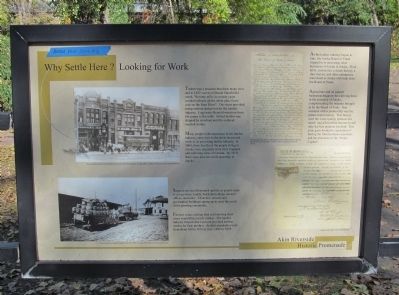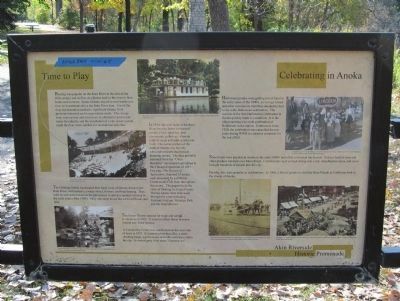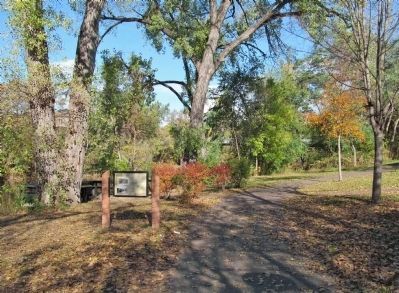Anoka in Anoka County, Minnesota — The American Midwest (Upper Plains)
Why Settle Here? / Time to Play
Why Settle Here? Looking for Work
Timber was a resource that drew many west and in 1847, surveyor Daniel Stanchfield noted, "Seventy mills in seventy years couldn't exhaust the white pine I have seen on the Rum River". The rivers provided transportation and power for the lumber industry. Logs were floated down river from the camps to the mills. Milled lumber was shipped by riverboat until the railroad reached Anoka.
Many people with experience in the lumber industry came west in its promising timber industry. In 1860, three fourths of the people living in Anoka were originally from New England and adjoining areas of Canada. By 1879, there were four saw mills operating in Anoka.
Support services blossomed quickly as people came to set up stores, hotels, blacksmith shops, doctors' offices, and more. Churches, schools and government buildings sprang up to meet the needs of the growing community.
Farmers came, seeking land and knowing their crops would find a ready market. The lumber industry helped clear land and provided another market for farm produce. Anoka's population went from about 300 in 1855 to over 1,400 by 1870.
As the lumber industry began to fade, the Anoka Board of Trade stepped in to encourage other businesses to locate in Anoka. Flour mills, creameries, a starch factory, a shoe factory, and other enterprises were lured to Anoka with help from the Board of Trade.
Agriculture and its support businesses began to be a driving force in the economy of Anoka, complementing the industry brought in by the Board of Trade. One example of this partnership was the potato starch factory. This factory used the lesser quality potatoes for starch and allowed the farmers to sell only the best potatoes for food. This soon gave Anoka the reputation of having the finest potatoes anywhere and the nickname of the "Potato Capital".
Time to Play • Celebrating in Anoka
Boating was popular on the Rum River at the turn of the 20th century and well-to-do citizens took to the river in their boats each summer. Some citizens stayed several weeks at a time on houseboats above the Rum River dam. Use of the river for recreation marked a significant change from previous industrial and transportation needs. The change from water power and river boats to alternative power and trains for industry and the installation of a city sewer system made the river more suitable for recreational activities.
The Giddings family landscaped their backyard, which ran down to the Rum River, with terraces, a water wheel, flowers, and boat landing. They built several stone houses to be quiet places to spend a summer evening in the early years of the 1900's. Only one stone house has survived floods and time.
In 1914, the west bank of the Rum River became home to musical events, plays, speeches, and community gatherings when an outdoor stage and seating area was built. The center portion of the outdoor theatre was built by subscription-individual people donating money. The idea probably stemmed from the "Cities Beautiful" movement highlighted at the Chicago Exposition of 1893. One play, The History of Agriculture, featured 13 scenes each presented by a different Commercial Club from throughout the county. The pageant told the story of farming in Anoka County. Various names have been used through the years including Eastman Stadium, Windego Park, and the Amphitheater.
The Green Theater opened for stage and screen productions in 1915. It stood on Main Street between Second and Third Avenue.
A Community Center was established on the west side of town in 1937. It featured a bowling alley, a skeet shooting range, a golf course, and other activities within the city. A contest gave it the name "Greenhaven".
Halloween pranks were getting out of hand in the early years of the 1900's, so George Green and other community members decided to host a city-wide Halloween celebration. The success of the first Halloween Celebration in Anoka quickly made it a tradition. It is the oldest running city-wide celebration of Halloween in the nation. Continuous since 1920, the celebration was cancelled for two years during WWII to conserve resources for the war effort.
Street Fairs were popular in Anoka in the early 1900's and often celebrated the harvest. Palaces built of corn and other produce towered over Main Street. Carnival acts such as high diving into a tub, wheelbarrow races, and more brought hundreds of people into the city.
Parades, too, were popular as celebrations. In 1900, a flower parade to rival the Rose Parade in California took to the streets of Anoka.
Akin Riverside Historic Promenade
Topics and series. This historical marker is listed in these topic lists: Agriculture • Entertainment • Industry & Commerce • Settlements & Settlers. In addition, it is included in the Minnesota Historical Society series list. A significant historical year for this entry is 1847.
Location. 45° 11.766′ N, 93° 23.553′ W. Marker is in Anoka, Minnesota, in Anoka County. Marker can be reached from River Avenue, 0.1 miles west of 1st Avenue. Marker is in Akin Riverside Park. Touch for map. Marker is at or near this postal address: 1721 River Avenue, Anoka MN 55303, United States of America. Touch for directions.
Other nearby markers. At least 8 other markers are within walking distance of this marker . The Gathering Place (here, next to this marker); Perseverance Needed (about 300 feet away, measured in a direct line); Windego Park Auditorium (about 500 feet away); Robert W. Akin (about 600 feet away); The Stone House (about 600 feet away); Father Louis Hennepin's Exploration in 1680 (approx. 0.2 miles away); Who Lived Here / Neighborhood Names / Building a Community (approx. 0.2 miles away); Aaron Greenwald (approx. ¼ mile away). Touch for a list and map of all markers in Anoka.
More about this marker. Why Settle Here captions:
• Shops along the south side of main Street between First and Second Avenue, ca. early 1900's. Courtesy of the Anoka County Historical Society.
• Loads of fresh potatoes coming from Anoka for sale, early 1900's. Courtesy of the Anoka County Historical Society.
• The first page of the Articles of Incorporation for the Anoka Board of Trade and the certificate of incorporation. Courtesy of the Anoka County Historical Society.
• Courtesy of the Anoka County Historical Society.
opposite side – Time to Play captions:
• This hand colored image shows a houseboat on the Rum River near Anoka, ca. 1904. Courtesy of the Anoka County Historical Society.
• This outdoor theatre could seat 1,600 people for plays, political speeches, concerts, and gatherings. Courtesy of the Anoka County Historical Society.
• These stone houses were places to catch a cool breeze from the river or to just enjoy the view. Courtesy of the Minnesota Historical Society.
• A tradition in Anoka is the Children's Parade for the schools. These students are from Lincoln Elementary. Courtesy of the Anoka County Historical Society.
• The Flower Parade in September of 1900 brought carriages decked in flowers and horses with flower covered harnesses. Courtesy of the Anoka County Historical Society.
• This hand-colored print features the 1907 Street Fair, a harvest celebration with a corn and potato palace. Courtesy of the Anoka County Historical Society.
Credits. This page was last revised on October 13, 2020. It was originally submitted on December 30, 2013, by Keith L of Wisconsin Rapids, Wisconsin. This page has been viewed 708 times since then and 30 times this year. Photos: 1, 2, 3. submitted on December 30, 2013, by Keith L of Wisconsin Rapids, Wisconsin.


